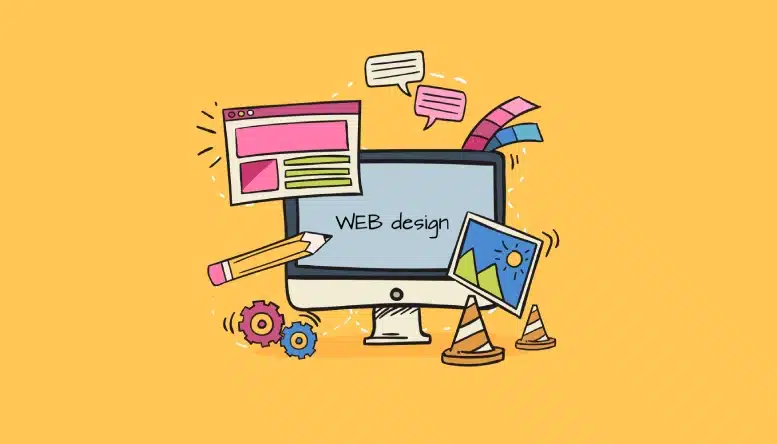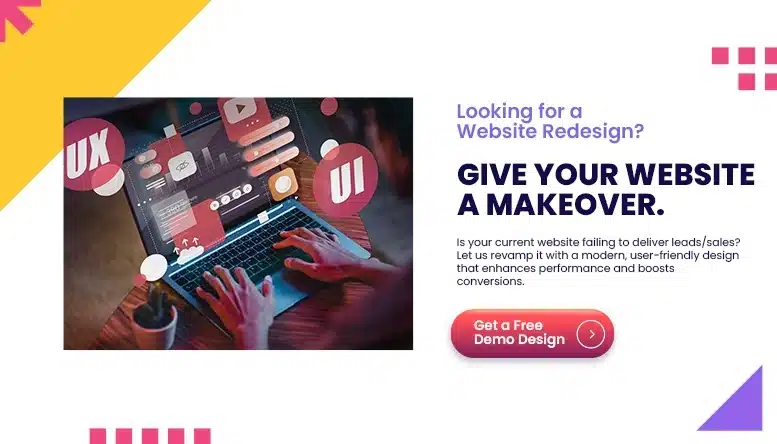Web design is the well-structured process of creating visually delightful, functional, and user-friendly websites for business and personal purposes. It encompasses making layouts, determining color schemes, creating designs, and ensuring a website’s look aligns with the brand that it represents. Though web development concerns itself with technical issues such as coding and server administration, working on a design with a reliable web designing company in Dubai is concerned only with the appearance and feel of a website. But what is web designing?, and why do organizations need it nowadays? Let’s dive in.
The difference between web development and web design
Many of us confuse web development with web design. Both constitute elements required to get a website up and running, but their roles are quite different.
Web Design
Imagine designing a website as an architect. A web designer is more concerned with the aesthetic appeal of the website. This ranges from layout design, and color palettes to typography, images, and all graphics. It is the artistic dimension of building a website, which must always align with the brand, and be quite appealing to the target population.
Web development
Web development is the engineering part of web pages. Developers use computer languages (programming languages) such as HTML, CSS, and JavaScript to make graphical designs into working websites ultimately giving life to the website design. They set up the technological architecture of the site and ensure that everything is fine on any device or browser.
Tasks of Web Designers in Creating the Visual Balance
Web designers have a list of responsibilities apart from making a website look good. The most critical roles include the following:
-
Layout and aesthetic design
A web designer conceives or thinks out and devises a plan of where the different elements on a website would go. They ensure the layout is not complicated so that it also allows for easy navigation from the user’s side
-
Brand Consistency
One of the most important elements involves maintaining brand consistency. The looks of the website should ensure that they are consistent with the brand’s current identity. This includes the typeface, color palettes, and even tone to ensure consistency in every message.
-
User Experience Design
Modern web design primarily deals with the user experience. Now, it is not about making things look great; it is about providing a smooth way for the user. This involves the designers anticipating consumers’ needs and taking care of the flow of navigation and clear calls to action.
-
Mobile Friendly Design
The significant part today, however, is that more than half of the total internet usage nowadays is made up of mobile traffic. Web designers therefore have to ascertain that the sites they produce are responsive-they perform on a smartphone as effectively as they do on a desktop. First and foremost, prototypes and mockups stand out as among the most essential tasks.
The design team may also be involved in building prototypes of the site before it is actually constructed. Prototypes can allow stakeholders to view an approximation of how the final product will appear and correct any mistakes prior to the actual building of the site.
-
Team Collaboration with Developers
While the actual building of the site occurs rarely through the direct efforts of the designers, the designer must still collaborate in the development process to ensure that the designs are implemented properly.
Benefits of Having an Excellent Website Design
Why do great web designs matter to businesses? In all honesty, the benefits are tremendous and far-reaching beyond aesthetic and beauty concerns, including business growth, customer engagement, and much more.
-
Good First Impression
First impressions do matter in a digital world. Every visitor who comes to the website has it as the first influencing factor that determines if he will stay on or leave. A well-designed site will catch customers’ attention and makes a great image of your company in their minds.
-
More engagement.
The beauty and intuitiveness of a website hold people’s interest longer. Good button placement, readable fonts and interactive elements actually motivate people to make movements on your website and interact with the information.
-
Brand Credibility
A business-looking website tends to instill faith in your viewers. Users are more likely to trust and engage themselves with the brand if the website of it is clean and not messy in contrast with the one having an outdated or bad design of UI.
-
SEO Benefits
The development of the website plays its importance, and SEO is more common to the world. But Google and all other search engines favor sites that load fast, are mobile-friendly, and have a clean navigational layout.
-
Effective Conversion Rates
A user-friendly and visually appealing website automatically results in increased conversion rates. If your visitors can easily find their way around your website and find what they need, the chances are higher for them to be customers.
Major Building Blocks of Web Design
There are several basic design elements that make up a great website. All of these factors must work in tandem to create a useful experience.
Color Scheme
The colors you use on your website tend to determine what people think about your brand. Designers are compelled to exercise extra caution during the process of selecting color palettes as they must define the branding’s identity while also allowing readable and accessible content.
Typography
Typography refers to the typefaces used on websites. Picking the right font helps express the desired atmosphere and feeling. A fun brand would select curvy, easy-going typefaces, whereas a law office probably would select more professional, serif fonts.
Imagery
Good-quality photographs are needed for web design. Images separate words and make the text rather interesting. Designers of websites frequently decide to use images that reflect the personality of the brand and may also appeal to the desired target audience.
Whitespace
Whitespace, also referred to as negative space, involves white areas within a page. Conversely, it is crucial because it gives room to breathe within the design to make the information easier to read and the design more cohesive overall.
Buttons and CTAs
CTAs instruct visitors to perform an action, such as to subscribe to a newsletter or to make a purchase. For the most part, to drive as many conversions as possible, these buttons must be enticing and presented well.
Web Design Tools Innovating the Future
From its humble roots, web design has evolved significantly in that designers can create stunning, effective websites. Here are some of the most sought-after web design tools to make fantastic websites:
Adobe XD
The next one on the list is Adobe XD, which has become a huge favorite of designers as an online development tool for prototype building. The creation of wireframes and an interactive prototype ensures giving the client an idea about how the website will work.
Figma
It has been a favorite of designers because of its cloud-based platform, real-time collaboration facility, and being perfect to use for prototyping. However, the design freedom that Figma offers is unbeatable.
Sketch
Sketch remains popular among Mac users because of its simplicity and functionality. With it, you can easily design interfaces, wireframes, and prototypes.
InVision
InVision is a prototype tool that lets the designers create completely interactive mock-ups. It also allows for real-time input; hence, teams can easily collaborate on the design projects.
Canva
Canva is well known for graphic design, but it is a very good tool for web designers who have to deliver images, banners, and other design elements for their websites.
Responsive web design: Designing for every screen.
Responsive web design is a strategy in which a website adjusts itself on various screen sizes, be it when viewed from a desktop, tablet, or smartphone. With so many people accessing the Internet today through mobiles, responsive design has been the new basic element of web design.
A responsive website changes its layout to suit the screen size. It will ensure that however consumers are accessing this it is consistent and user-friendly on whatever device they are coming in on.
Advantages of Responsive Design
Increased consumer happiness: A site that loads well and works on multiple devices increases consumer happiness.
SEO Friendly: Responsive sites are Google-friendly among others that might improve your ranking.
Low-cost: In contrast to the development of a separate website for both desktop and mobile, a responsive design includes all possible platforms in just one solution.
FAQ: Answers to Common Web Design Questions
1) What is the key feature of web design?
The most essential aspect of web design is user experience (UX). A lovely website is of little use if its customers are disheartened by its usability.
2) How long does a website take to develop?
The complexity of the site developed even by the best web design agency Dubai has to offer determines how long it will take to design. A simple website can be a matter of a few weeks, but more elaborate ones could take months.
3) Can I change my website without losing its content?
Yes. A redesign focuses on visual features. You may retain the same content while improving how your website looks and feels
4) What is the difference between wireframes and prototypes?
A wireframe is the basic layout of a site. A prototype is an interactive mock-up that models how a website will function when fully finished.
4) Do Web designers need to know how to code?
Not necessarily. Though knowing how to code is handy for a designer, many design tools now let them focus only on graphics rather than on making code.


